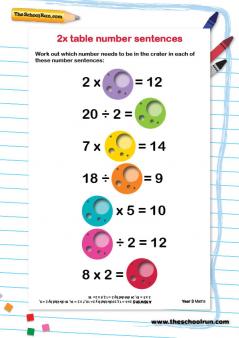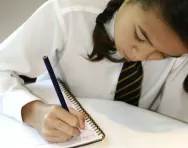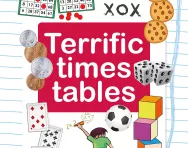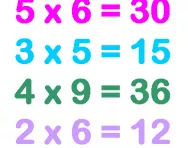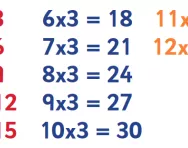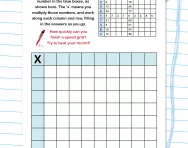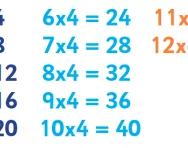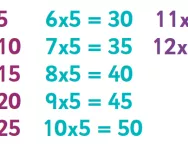Important update from TheSchoolRun
For the past 13 years, TheSchoolRun has been run by a small team of mums working from home, dedicated to providing quality educational resources to primary school parents. Unfortunately, rising supplier costs and falling revenue have made it impossible for us to continue operating, and we’ve had to make the difficult decision to close. The good news: We’ve arranged for another educational provider to take over many of our resources. These will be hosted on a new portal, where the content will be updated and expanded to support your child’s learning.
What this means for subscribers:
- Your subscription is still active, and for now, you can keep using the website as normal — just log in with your usual details to access all our articles and resources*.
- In a few months, all resources will move to the new portal. You’ll continue to have access there until your subscription ends. We’ll send you full details nearer the time.
- As a thank you for your support, we’ll also be sending you 16 primary school eBooks (worth £108.84) to download and keep.
A few changes to be aware of:
- The Learning Journey weekly email has ended, but your child’s plan will still be updated on your dashboard each Monday. Just log in to see the recommended worksheets.
- The 11+ weekly emails have now ended. We sent you all the remaining emails in the series at the end of March — please check your inbox (and spam folder) if you haven’t seen them. You can also follow the full programme here: 11+ Learning Journey.
If you have any questions, please contact us at [email protected]. Thank you for being part of our journey it’s been a privilege to support your family’s learning.
*If you need to reset your password, it will still work as usual. Please check your spam folder if the reset email doesn’t appear in your inbox.
Learning the 2 times table: tips and tricks
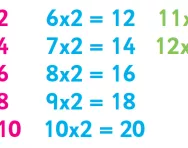
The 2 times table is the most important, and the one most likely cause problems if children have learned to count in multiples, as it is hard to replace two-four-six-eight with a table that alternates between single numbers and twos (1 x 2 = 2, 2 x 2 = 4, etc).
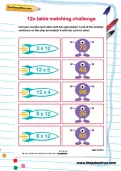
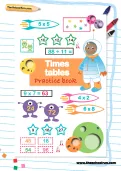
Get FREE Times Tables Resources
- Printable and interactive worksheets
- Practice workbook
- Games pack
Step one: be consistent in your recitation
How do you say the 2 times table? When you practise with your child it's vital to be consistent in how you recite the number sequence out loud. Choose either "One two is two, two twos are four, three twos are six, four twos are eight", etc., or "Two ones are two, two twos are four, two threes are six, two fours are eight" as a starting point. If your child is learning times tables at school use the same form, so that they're less likely to mix the two up.
Step two: take it slowly
Take the table up to 5x2 to start with, and practise until this is fluent and accurate.
Children often go wrong at 3x2. If this happens, go back to 2x2 and model the step, again using whichever form the school uses. Don't rush – brain cell connections are formed slowly in the first instance, and learning this table is creating a template for learning the others. Getting the columns mixed up (saying "two threes are six, three threes are..." by mistake) is much more about learning co-ordination than learning maths. Provided your child is getting just a little better each time, it's not a problem if they takes a little longer to learn than other children you know.
If, though, they really find this stage hard, use a pile of 2p pieces as maths aids and have them count and say the table at the same time. Once they can say the table with the coins, take them away and try without. Have your child write down what he or she has just learned. Once they make it to 5x2 without any hitches, complete the table. Ask your child if 2 is an odd or even number. If they know, then point out that every number in an even-number table is even. If not, then explain the difference between odd and even numbers, then make the same point.
Step three: single out items from the table
The next step is to call out individual items from the table: 7x2, 11x2, etc. If they get things right straightaway, praise. If not, go back to an item in the table one or two before the error and have them say the table until they reach the error. Prompt if need be. For example:
If necessary, go back one to five twos. Always go back to a calculation that is known, and build from there.
Step four: help your child picture the numbers in columns
I often write out 2s in three columns, like this: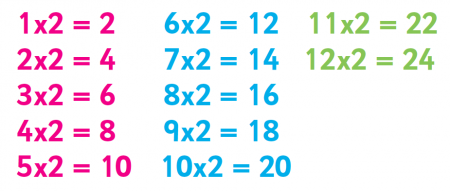
I then point out that, once we have reached 5x2, the series of final figures repeats itself. This helps build understanding of numbers and prepares children for larger tables with even numbers.
2 times table tips and tricks
- For schools, I recommend focusing assistants' and volunteers' attention on getting 2s right and providing practice matched to individual needs. If 2s are not right, nothing else will be and children will try to recall higher tables by guessing. We do not guess – we think through, work out and understand.
- Try to have your child anticipate your questions, or ask you questions.
- Put in questions about the table at the oddest times, so that even asking a question becomes a little joke. For example, I sometimes pretend it is part of a perfectly normal conversation about something else, when of course it's not. The dead-pan approach can be quite amusing!
2 times tables practice worksheets and games
For a selection of 2 times tables worksheets see below.
Read John Bald's guide to times table learning for more general advice about multiplication tables, then browse through all times table worksheets and printable games.


